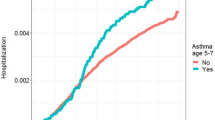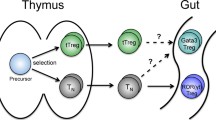Abstract
T-lymphocytes may preferentially differentiate towards a Th1 subtype, which is thought to be involved in the autoimmune aspects of diabetes, or a Th2 subtype, which is thought to mediate allergic disease. The activation of one subtype is thought to inhibit the other. To determine if diabetes is less common among those with allergic disease, consistent with the postulated TH1/Th2 paradigm, we used data from the 2000–2001 Canadian Community Health Survey of those at least 12 years of age from 125,159 households. Diabetes requiring insulin was reported in 1% whether or not allergies were reported. The crude odds ratio between diabetes and allergies for the entire population was 1.06 (95% confidence interval (CI): 0.90, 1.24). Adjusted for household size, number of bedrooms, immigrant status, income adequacy, educational level, smoking status, alcohol drinking status, regular exercise, and age, there was a positive association between allergy and diabetes with an odds ratio of 1.25 (95% CI: 1.06, 1.49). These results do not provide evidence for the existence of the Th1/Th2 paradigm as a determinant of disease patterns in the general population.
Similar content being viewed by others
Reference
PZ Zimmet (1995) ArticleTitleThe pathogenesis and prevention of diabetes in adults Diabetes Care 18 IssueID7 1050–1064 Occurrence Handle7555542
JP Palmer (2003) ArticleTitleWhat’s in a name: Latent autoimmune diabetes of adults, type 1.5, adult-onset, and type 1 diabetes Diabetes Care 26 IssueID2 536–538 Occurrence Handle12547896
JE Shaw PZ Zimmet D McCarty M Courten Particlede (2000) ArticleTitleType 2 diabetes worldwide according to the new classification and criteria Diabetes Care 23 IssueID2 B5–B10 Occurrence Handle10860184
A Gottsater M Landin-Olsson P Fernlund A Lernmark G Sundkvist (1993) ArticleTitleBeta-cell function in relation to islet cell antibodies during the first 3 year after clinical diagnosis of diabetes in type II diabetic patients Diabetes Care 16 IssueID6 902–910 Occurrence Handle8325204
M Landin-Olsson KO Nilsson A Lernmark G Sundkvist (1990) ArticleTitleIslet cell antibodies and fasting C-peptide predict insulin requirement at diagnosis of diabetes mellitus Diabetologia 33 561–568 Occurrence Handle10.1007/BF00404145 Occurrence Handle2253834
AD Pradhan JE Manson N Rifai JE Buring PM Ridker (2001) ArticleTitleC-reactive protein, interleukin-6, and risk of developing type 2 diabetes mellitus J Am Med Assoc 286 IssueID3 327–334 Occurrence Handle10.1001/jama.286.3.327
J Spranger A Kroke M Mohlig et al. (2003) ArticleTitleInflammatory cytokines and the risk to develop type 2 diabetes: Results of the prospective population-based European Prospective Investigation into Cancer and Nutrition (EPIC)-Potsdam Study Diabetes 52 IssueID3 812–817 Occurrence Handle12606524
FB Hu JB Meigs TY Li N Rifai JE Manson (2004) ArticleTitleInflammatory markers and risk of developing type 2 diabetes in women Diabetes 53 IssueID3 693–700 Occurrence Handle14988254
SR Durham SJ Till CJ Corrigan (2000) ArticleTitleOrgan-specific effects of systemic inflammatory activation – T-lymphocytes in asthma: Bronchial versus peripheral responses J Allergy Clin Immunol 106 IssueID5 S221–S226 Occurrence Handle10.1067/mai.2000.110154 Occurrence Handle11080735
MA Atkinson GS Eisenbarth (2001) ArticleTitleType 1 diabetes: New perspectives on disease pathogenesis and treatment Lancet 358 221–229 Occurrence Handle10.1016/S0140-6736(01)05415-0
J Kero M Gissler E Hemminki E Isolauri (2001) ArticleTitleCould TH1 and TH2 diseases coexist? Evaluation of asthma incidence in children with coelica disease, type 1 diabetes, or rheumatoid arthritis: A registered study J Allergy Clin Immunol 108 IssueID5 781–784 Occurrence Handle10.1067/mai.2001.119557 Occurrence Handle11692104
InstitutionalAuthorNameStatistics Canada (1995) National Population Health Survey 1994–1995 Statistics Canada Ottawa, Ontario
Cycle 2 and beyond: Preparing and storing longitudinal data of the National Population Health Survey. Proceedings of Statistics Canada Symposium 98. 1998
MP Peaudet J Chen C Perez et al. (1998) National Population Health Survey Overview 1996/1997 Statistics Canada Ottawa, Canada
Y Chen R Dales M Tang D Krewski (2002) ArticleTitleObesity in women but not in men may increase the incidence of asthma: Longitudinal observations from the Canadian National Population Health Surveys Am J Epidemiol 155 IssueID3 1–7 Occurrence Handle10.1093/aje/155.1.1 Occurrence Handle11772777
National Diabetes Data Group. Classification and diagnosis of diabetes mellitus and other categories of glucose intolerance. National Diabetes Data Group. Diabetes 1979; 1039–1057
AS Krolewski JH Warram LI Rand CR Kahn (1987) ArticleTitleEpidemiologic approach to the etiology of type I diabetes mellitus and its complications NEJM 317 IssueID22 1390–1398 Occurrence Handle3317040
CJ Skinner D Holt TMF Smith (1989) Analysis of Complex Surveys John Wiley & Sons Ltd New York, NY
JNK Rao CFJ Wu (1998) ArticleTitleResampling inference with complex survey data J Am Statist Assoc 83 231–241
JNK Rao CFJ Wu K Yue (1992) ArticleTitleSome recent work on resampling for complex surveys Surv Methodol 18 209–217
InstitutionalAuthorNameSAS Institute I (1996) SAS Procedures Guide. 6.12. Cary SAS Institute, Inc. NC
MR Sears B Burrows EM Flannery GP Herbison MD Holdaway (1993) ArticleTitleAtopy in childhood I gender and allergen related risks for development of hay fever and asthma Clin Exp Allergy 23 IssueID11 941–948 Occurrence Handle10779282
InstitutionalAuthorNameAnonymous. EURODIAB ACE Study Group (2000) ArticleTitleVariation and trends in incidence of childhood diabetes in Europe Lancet 355 873–876
Saydah (2002) ArticleTitleAge and the burden of death attributable to diabetes in the United States Am J Epidemiol 156 714–719 Occurrence Handle10.1093/aje/kwf111 Occurrence Handle12370159
M Tang Y Chen (2000) ArticleTitlePrevalence of diabetes in Canadian adults aged 40 years or older Diabetes Care 23 1704–1705 Occurrence Handle11092298
DP Strachan (1989) ArticleTitleHay fever, hygiene, and household size Br Med J 299 1259–1260
PM Matricardi F Rosmini L Ferrigno et al. (1997) ArticleTitleCross sectional retrospective study of prevalence of atopy among Italian military students with antibodies against hepatitis a virus Br Med J 314 999
E Mutius Particlevon FD Martinez C Fritzsch T Nicolai P Reitmeir H-H Thiemann (1994) ArticleTitleSkin test reactivity and number of siblings Br Med J 308 692–695
T Shirakawa T Enomoto SI Shimazu JM Hopkin (1997) ArticleTitleThe inverse association between tuberculin responses and atopic disorder Science 275 77–79 Occurrence Handle8974396
CR Simpson WJA Anderson PJ Helms et al. (2002) ArticleTitleCoincidence of immune-mediated diseases driven by Th1 and Th2 subsets suggests a common aetiology. A population-based study using computerized general data Clin Exp Allergy 32 37–42 Occurrence Handle10.1046/j.0022-0477.2001.01250.x Occurrence Handle12002734
JF Bach (2002) ArticleTitleThe effect of infections on susceptibility to autoimmune and allergic diseases NEJM 347 IssueID12 911–920 Occurrence Handle10.1056/NEJMra020100 Occurrence Handle12239261
A Sheikh L Smeeth R Hubbard (2003) ArticleTitleThere is no evidence of an inverse relationship between TH2-mediated atopy and TH1-mediated autoimmune disorders: Lack of support for the hygiene hypothesis J Allergy Clin Immunol 111 131–135 Occurrence Handle10.1067/mai.2003.8 Occurrence Handle12532108
Author information
Authors and Affiliations
Corresponding author
Rights and permissions
About this article
Cite this article
Dales, R., Chen, Y., Lin, M. et al. The Association Between Allergy and Diabetes in the Canadian Population: Implications for the Th1-Th2 Hypothesis. Eur J Epidemiol 20, 713–717 (2005). https://doi.org/10.1007/s10654-005-7920-1
Accepted:
Issue Date:
DOI: https://doi.org/10.1007/s10654-005-7920-1




